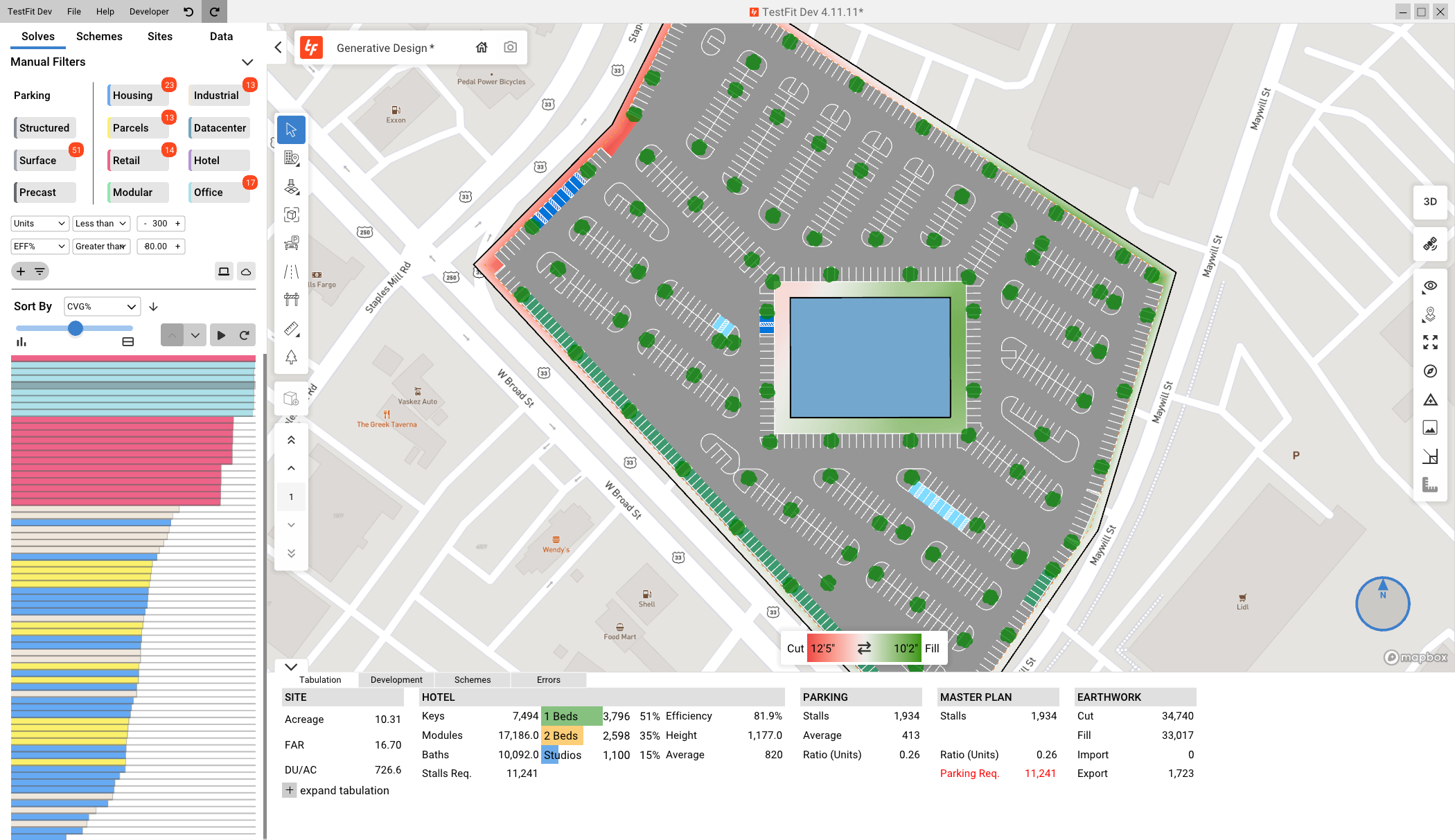In the 1980s, I was a young architect assigned to a laboratory project with a more senior professional. At the outset, the client wanted us to present alternatives. We developed three solutions. If TestFit’s new generative design tool had been available back then, the number would have been around twenty-five thousand.
Why did we settle with three at the time? My more experienced colleague explained that three is a perfect number. It gives room for all those involved to have a say without a fight over two opposing designs.
The trick was to make one of the solutions unacceptable and another OK, but with some issues that would not please anyone. The third—which you wanted to win—should be superior and likable. The client would be satisfied because they could choose and pick the clear winner.
Fast forward to 2024

Today, we can use generative AI to churn out a massive volume of designs from given constraints. Will that lead to better outcomes, or will building design follow the music industry’s lead, resulting in a lot of content with little creativity?
I talked with Clifton Harness, the Co-Founder and CEO at TestFit, to learn more about their approach to generative design.
TestFit, an optimizer since 2016
TestFit, a Dallas, Texas startup, has been at the forefront of building optimization since 2016. Clifton explains that they’ve been “successful in housing and very successful in warehousing” – two opposites of the spectrum.
“We decided that we wanted to spend our lives working on something meaningful and try to dream a big dream that could be something that could change the world,” he says. “We are not going to be able to change how Americans live, but we can certainly minimize the impact of parking and cars on our environment using AI.”
TestFit Site Solver, one of the most potent computational AI co-creation tools today, allows users to generate site plans instantly with real-time insights into design, cost, and constructability.
The new Generative Design
On June 26, 2024, TestFit launched Generative Design, a building optimization tool that uses computational artificial intelligence. It is the company’s answer to feasibility study and early design needs where tools like Revit are too cumbersome.
“We just want the parti to be the best parti that you could ever get out of this site. That’s our goal,” Clifton summarizes the purpose of the new application.
Generative Design allows AI to test site solutions independently based on specific project requirements. Users can easily define the targets they need for the following building types:
- Housing
- Subdivisions
- Retail
- Modular
- Industrial
- Data Centers
- Hotel
- Office
- Parking (Structured, Surface, Precast)
Clifton says you can generate “25 thousand results in 10 seconds” with their tool. The filters allow you to sort and limit the number of designs you want to work on. The filters include:
- Units
- Average Unit Area
- Parking Ratio
- Net Rentable Square Feet
- Site Efficiency
- Height of Building
- Floor Area Ratio (FAR)
- Unit Density (Dwelling Units per Acre)
- Site Coverage
I asked Clifton whether they considered adding sustainability metrics to the mix. He said it’s not their specific mission because other companies do it incredibly well. However, this does not mean TestFit does not help achieve environmental goals.
“If you’re getting 1% more efficient buildings than every 100 buildings that you build, you didn’t have to build one, which literally is the goal of sustainability, is to just not build the building you don’t need to build,” he points out.
As an architect, I would have loved to have this tool at my disposal. It would have saved a lot of time and well-thought-out alternatives for the designer and the client to evaluate. However, there are other potential users as well.
“The hope is that if we can get that sort of user experience right, it might not just be architects and developers, it might be civil engineers, it might be cities themselves or brokers or landowners,” Clifton notes.
In any case, AI does not make you an expert. Generative Designer is a co-creation tool for people who know what they’re doing.
If you can, should you?
Many creative professionals have mixed feelings about generative AI. They fear that “democratizing” design will diminish their work’s value or make them obsolete. “You shouldn’t do it just because you can,” as one architect told me when we discussed design automation.
The goal of a construction project is the best possible solution from the client’s, users’, and environmental perspectives. Any technology or tool that takes us closer to that goal is worth trying. Still, many AI companies make the technology “the hero” that will save you. That is off-putting for many creatives. The real hero should be the user with a problem they must solve.
From my discussion with Clifton, it’s evident that his heart is in the right place. Drawing on his design background, he is resolving real issues with innovative technology.
“We have used the 8000 customer meetings that we have had over the last seven years to provide enough information for what the architect and the development community really need and the parameters that they really care about,” he explains.
Trying it out
I’m looking forward to testing Generative Design when it becomes available on July 10. There will be a free version for exploring the possibilities and a paid version with enhanced capabilities.
Join the waitlist and check out TestFit’s press release for more information, and visit their site at testfit.io.
View the original article and our Inspiration here


Leave a Reply